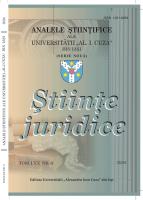Implicațiile practice ale inteligenței artificiale în autentificarea artefactelor de patrimoniu cultural și în identificarea falsurilor și a contrafacerilor în artă
The practical implications of Artificial Intelligence in authenticating cultural heritage artifacts and identifying forgeries and counterfeits in art
Author(s): Ion Sandu, Sorin Alămoreanu, Viorica Vasilache, Vasile Drobotă, Andrei Victor Sandu, Ana Drob, Petru Ovidiu Tănasă, Ioan Cristinel NegruSubject(s): Law, Constitution, Jurisprudence, Criminal Law, History of Art
Published by: Editura Universităţii »Alexandru Ioan Cuza« din Iaşi
Keywords: artifact; forgery and counterfeiting; experimental protocol; authentication; valorization; artificial intelligence (IA);
Summary/Abstract: This paper focuses on the practical implications of Artificial Intelligence (AI) assisted by instrumental analytical methods, which, through the data obtained, provide novel evidentiary systems, such as the identification of new archaeometric and chemometric characteristics experimentally validated and sequentially processed for dating, period classification, and attribution to an author, school, or geographical area. The integration of AI significantly eases the work of art investigators. Collaboration between an AI specialist and a scientific art expert will always enhance the degree of validation regarding the authenticity of an artifact. AI enables the utilization of historical information about materials and their state of preservation to determine when and where an object was created by employing new approaches in the field. This involves an integrated AI strategy in decision making processes using multi analytical experimental systems, offering a “cumulative synthesis” that surpasses the professional intuition and instinct of art historians. This is achieved through the interpretation of analytical data provided by technical scientific experts, allowing for the validation of real evidentiary characteristics. Thus, AI increasingly establishes itself as a practical domain with exceptional potential for complex analyses in authentication and attribution of authorship for newly discovered or scarcely studied artifacts. The co assistance and corroboration between an AI specialist and a scientific art expert will always prove beneficial in enhancing the validation of inquiries by providing answers as close to the truth as possible. This includes authentication, assessment of the state of preservation, and determination of patrimonial value through market or catalog rankings.
Journal: Analele Științifice ale Universităţii Alexandru Ioan Cuza din Iași, seria Ştiinţe Juridice
- Issue Year: LXX/2024
- Issue No: 4
- Page Range: 87-104
- Page Count: 18
- Language: Romanian

